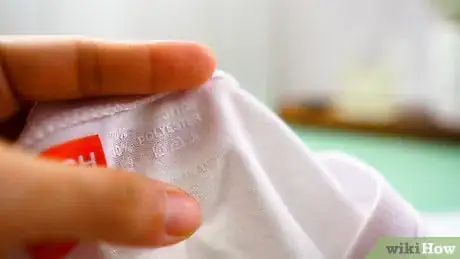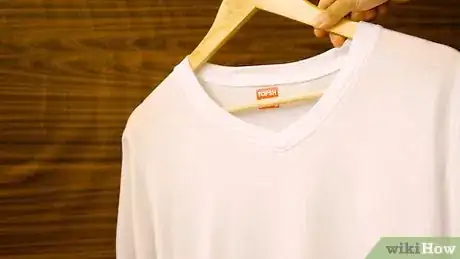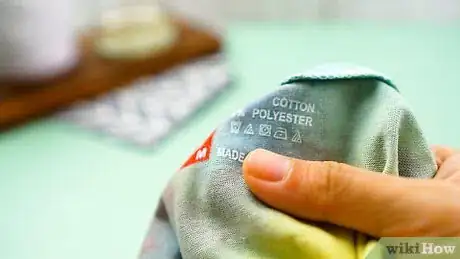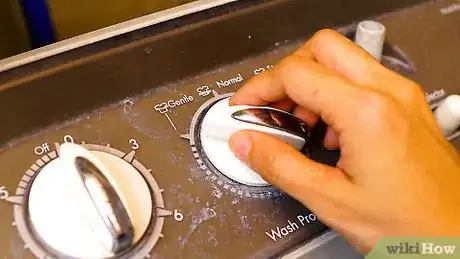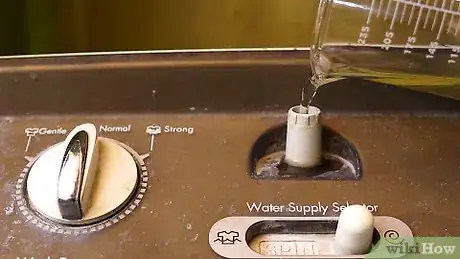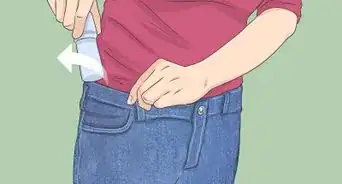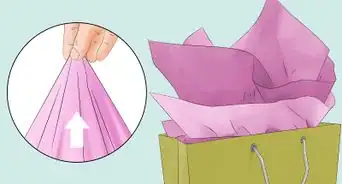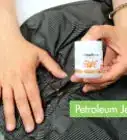This article was co-authored by Susan Stocker and by wikiHow staff writer, Amber Crain. Susan Stocker runs and owns Susan’s Green Cleaning, the #1 Green Cleaning Company in Seattle. She is well known in the region for outstanding customer service protocols — winning the 2017 Better Business Torch Award for Ethics & Integrity —and her energetic support of green cleaning practices.
There are 10 references cited in this article, which can be found at the bottom of the page.
This article has been viewed 16,317 times.
Liquid chlorine bleach is great for removing stains, whitening your whites, and disinfecting colored clothing, but it can be a little daunting to use! It’s a strong chemical, so you have to be careful. If used improperly, bleach can stain or fade colored items and even damage certain types of fabrics. The next time you want to bleach a load of clothes without worrying about ruining them, all you need to do is follow a few simple rules!
Steps
Bleaching White Clothes
-
1Read the fabric care label to make sure it’s safe to bleach your whites. Liquid chlorine bleach can damage delicate fabrics like silk, wool, leather, and many synthetics. Before you bleach your whites, take a moment to check each care tag and confirm the clothes are bleach-safe. If there are any special instructions on the care tag, always follow those directions.[1]
- If you don't see the words "bleach-safe" on the tag, look for a triangle symbol, which indicates the item is safe to bleach.[2]
- If the item doesn’t have a care tag and you aren’t sure what it’s made of, it's best to skip the bleach.
-
2Soak heavily soiled items in diluted bleach for 5 minutes to lift stains. Mix 1⁄4 cup (59 ml) of liquid bleach with 1 gallon (3.8 l) of warm water in a large bucket. Submerge the stained garment in the solution and let it sit for about 5 minutes so the bleach can work on the stains. Then, rinse the item with cool water and wring it out gently.[3]
- After doing the soak, you can either hang the item up to air-dry or proceed with washing the item with the rest of the load.
Advertisement -
3Load whites loosely in the washing machine to prevent discoloration. Overfilling the machine prevents items from circulating freely and may lead to discoloration and uneven results. If you have a large load of whites to bleach, break it up into 2 smaller loads for the best results![4]
-
4Set the washing cycle to “normal” to safely bleach most fabrics. Typically, you don’t need to bleach your whites using a special wash cycle—you can set the machine to the “normal” cycle. You may want to use the delicate cycle if you’re bleaching delicate fabrics or prized items.[5]
-
5Set the machine to the hottest water temperature to boost bleaching power. For the most whitening power, update the settings to use the hottest water temperature available. The only exception to this rule is if the care tag instructs you to avoid hot water—always defer to the care tag’s specific instructions.[6]
- The optimum temperature for whitening and disinfecting is 120–125 °F (49–52 °C). Many washing machines won’t allow you to set the water temperature that specifically, which is fine! Just use the hottest setting you have.
-
6Pour the recommended amount of bleach into the bleach dispenser. The amount of bleach you use will vary by product, so be sure to check the package instructions and use that amount. Most new washing machine models and front-loading washing machines have a special bleach dispenser situated right by the regular detergent dispenser. If your machine has a bleach dispenser, pour the recommended amount of bleach into it.[7]
- Most normal-sized loads will need about 3⁄4 cup (180 ml) of bleach. For large or heavily soiled loads, go with 1 1/4 cup (293 ml) of bleach.[8]
Tip: If your machine does not have a bleach dispenser, add the bleach to the washing machine drum 5 minutes after the cycle starts. That way, the water will disperse the bleach evenly through the load.
-
7Run an additional rinse cycle to remove the bleach scent. You don’t have to do this, but if you really hate the smell of bleach, set your washing machine to go through a final rinse cycle after the initial cycle ends. This should get rid of any pungent odors and remove any bleach from the fabric.[9]
-
8Dry freshly bleached whites as you normally would. Once your washing machine completes the cycle, your whites are bleached! You can pop them in the dryer or hang them up to air-dry, depending on what the care tag suggests.[10]
- If the stains aren’t completely gone, you can run the clothes through the same process once more.
Sanitizing Colored Clothing Safely
-
1Check the care tags to confirm the fabrics are bleach-safe. Liquid chlorine bleach can wreak havoc on colored fabrics! Always check the care tag on each item before using bleach. Most care tags will say “bleach-safe” or display a triangle symbol to indicate that you can use bleach safely.[11]
- If you see a triangle with 3 lines through the middle, you can only use non-chlorine (oxygen) bleach. Keep in mind that oxygen bleach does not disinfect fabrics like liquid chlorine bleach does.
- If the triangle is solid and has an “X” over it, do not use bleach.[12]
- Avoid using liquid chlorine bleach on silk, wool, spandex, mohair, leather, and other delicate fabrics.
-
2Spot-test colored fabrics with diluted bleach before laundering them. Dilute 2 teaspoons (9.9 ml) of liquid chlorine bleach with 1⁄4 cup (59 ml) of tap water. Dip a cotton swab into the mixture and dab it on the inside of a hem, cuff, or seam. After 1 minute, blot the area with a dry towel and see if the color faded.[13]
- You can proceed safely with bleaching the colored item as long as there's no color change.
- Even if the care tag says the item is bleach-safe, it’s a good idea to do a quick spot-test.
-
3Use the wash cycle and water temperature recommended on the care tag. Bleach disinfects best when used with hot water, but many colored fabrics can’t be safely washed in hot water without the color fading. Use the water temperature recommended on the care tag for the best results. A “normal” cycle is fine for most items, but set the machine to “delicate” for fragile fabrics.[14]
- If there’s no recommendation on the care tag, it’s best to err on the side of caution and use warm or cold water.
-
4Pour 3⁄4 cup (180 ml) of bleach into the machine’s bleach dispenser to prevent color loss. If your front-loading washing machine has a bleach dispenser, use it! It’s usually located right next to the regular detergent dispenser. The bleach dispenser will release the bleach at the perfect time during the cycle to prevent color loss, stains, and fading.[15]
Tip: If your machine doesn’t have a bleach dispenser, let the machine fill up with water, add the bleach, and swish it around before putting your clothes into the washing machine. Pouring undiluted bleach directly onto your clothing will fade the color and possibly ruin the item.
-
5Add regular laundry detergent to the dispenser and start the cycle. How much detergent you use depends on the product—some detergents are highly concentrated. Follow the directions on your detergent’s label. It’s best to use a high-quality detergent when you’re using bleach, since the cheaper brands may interfere with how well the bleach works.[16]
-
6Run an extra rinse cycle to remove the bleach smell. Bleach has a pretty pungent odor and it can linger in the fabric of your clothes after the wash cycle ends. If you dislike the scent, simply run the load through a final rinse cycle to remove any lingering bleach from the fibers. Then, you can dry the load of clothes as you normally would!
Expert Q&A
-
QuestionDoes bleach kill black mold?
 Susan StockerSusan Stocker runs and owns Susan’s Green Cleaning, the #1 Green Cleaning Company in Seattle. She is well known in the region for outstanding customer service protocols — winning the 2017 Better Business Torch Award for Ethics & Integrity —and her energetic support of green cleaning practices.
Susan StockerSusan Stocker runs and owns Susan’s Green Cleaning, the #1 Green Cleaning Company in Seattle. She is well known in the region for outstanding customer service protocols — winning the 2017 Better Business Torch Award for Ethics & Integrity —and her energetic support of green cleaning practices.
Green Cleaning Expert It really feels like it should, but it doesn't. Bleach will not kill black mold whether it's on a surface or on your clothes.
It really feels like it should, but it doesn't. Bleach will not kill black mold whether it's on a surface or on your clothes. -
QuestionWhat's better, chlorinated or non-chlorine bleach?
 Susan StockerSusan Stocker runs and owns Susan’s Green Cleaning, the #1 Green Cleaning Company in Seattle. She is well known in the region for outstanding customer service protocols — winning the 2017 Better Business Torch Award for Ethics & Integrity —and her energetic support of green cleaning practices.
Susan StockerSusan Stocker runs and owns Susan’s Green Cleaning, the #1 Green Cleaning Company in Seattle. She is well known in the region for outstanding customer service protocols — winning the 2017 Better Business Torch Award for Ethics & Integrity —and her energetic support of green cleaning practices.
Green Cleaning Expert I'm not particularly fond of chlorinated bleach. I think non-chlorine bleach is ideal in almost every scenario.
I'm not particularly fond of chlorinated bleach. I think non-chlorine bleach is ideal in almost every scenario.
Warnings
- Never mix chlorine bleach with ammonia or any other cleaning chemicals. Many combinations are hazardous and can produce toxic fumes.[17]⧼thumbs_response⧽
- Store bleach in a ventilated area where children and pets can't reach it.[18]⧼thumbs_response⧽
- Avoid breathing in bleach fumes.⧼thumbs_response⧽
Things You’ll Need
- Liquid chlorine bleach
- Regular laundry detergent
References
- ↑ https://www.cleaninginstitute.org/cleaning-tips/clothes/detergents/using-bleach-laundry
- ↑ https://www.clorox.com/how-to/laundry-basics/general-laundry-advice/what-symbols-on-care-tags-mean/
- ↑ https://www.clorox.com/how-to/laundry-basics/bleach-101/laundering-item-bleach/
- ↑ https://waterandhealth.org/disinfect/preventing-infection/how-to-clean-and-sanitize-laundry-to-help-prevent-the-spread-of-pathogens/
- ↑ https://www.whowhatwear.com/how-to-bleach-clothes/slide7
- ↑ https://www.ncconsumer.org/news-articles-eg/how-to-get-the-whitest-whites-using-bleach.html
- ↑ https://www.ncconsumer.org/news-articles-eg/how-to-get-the-whitest-whites-using-bleach.html
- ↑ https://waterandhealth.org/disinfect/preventing-infection/how-to-clean-and-sanitize-laundry-to-help-prevent-the-spread-of-pathogens/
- ↑ https://www.whowhatwear.com/how-to-bleach-clothes/slide7
- ↑ https://www.goodhousekeeping.com/home/cleaning/a24670/3-secrets-to-keeping-your-whites-white/
- ↑ https://www.cleaninginstitute.org/cleaning-tips/clothes/detergents/using-bleach-laundry
- ↑ https://waterandhealth.org/disinfect/preventing-infection/how-to-clean-and-sanitize-laundry-to-help-prevent-the-spread-of-pathogens/
- ↑ https://waterandhealth.org/disinfect/preventing-infection/how-to-clean-and-sanitize-laundry-to-help-prevent-the-spread-of-pathogens/
- ↑ https://www.goodhousekeeping.com/home/cleaning/a24670/3-secrets-to-keeping-your-whites-white/
- ↑ https://www.cleaninginstitute.org/cleaning-tips/clothes/laundering-problems-solutions
- ↑ https://www.ncconsumer.org/news-articles-eg/how-to-get-the-whitest-whites-using-bleach.html
- ↑ https://www.cdc.gov/healthywater/emergency/cleaning-sanitizing/household-cleaning-sanitizing.html
- ↑ https://www.beyondtoxics.org/work/green-home-cleaning-campaign/bleach/
